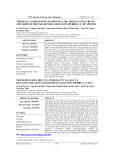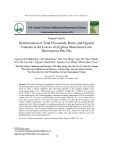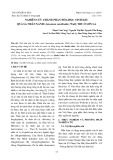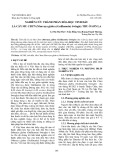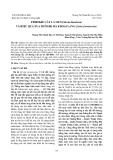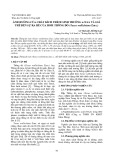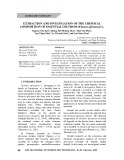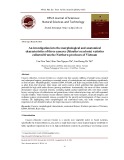
141
TAÏP CHÍ KHOA HOÏC VAØ COÂNG NGHEÄ ÑAÏI HOÏC COÂNG NGHEÄ ÑOÀNG NAI
Số: 03-2024
ANTI-INFLAMMATION ACTIVITY OF JATROPHA PODAGRICA
HOOK EXTRACTS COLLECTING IN DONG NAI
Tran Manh Hung1, Truong Phu Chi Hieu1, Pham Thi Hong Khuyen1, Huynh Loi2, Truong Thi
Giang3, To Dao Cuong4*
1The University of Danang
2Binh Dương University
3Dong Nai Technology University
4Phenikaa University
*Corresponding author: To Dao Cuong, cuong.todao@phenikaa-uni.edu.vn
1. INTRODUCTION
Inflammation represents the body's
systemic response to local injury, serving to
protect against damaging agents. It is a complex
biochemical and cellular process that occurs
within damaged tissue, giving rise to mediators
known as inflammatory cytokines exudates.
These substances play a crucial role in
defending the body against infection, as well as
promoting tissue recovery and wound healing
(Miranda et al., 2023).
All agents capable of causing local cell
damage and destruction possess the potential to
induce inflammation at the affected site. These
causal factors can be broadly categorized into
two main groups: external and internal.
External triggers of inflammation encompass
infections by bacteria, viruses, parasites, and
fungi, as well as physical factors like foreign
GENERAL INFORMATION
ABSTRACT
Received date: 02/05/2024
Jatropha podagrica Hook. belongs to the Euphorbiaceae
family, and has been traditionally used in folk medicine to
alleviate constipation, skin infections, jaundice, and fever. This
plant exhibits various pharmacological effects, including
antibacterial, anticancer, antioxidant, insect growth inhibition,
neuromuscular inhibition, and hypotensive properties. However,
its anti-inflammatory activity remains unexplored. In this study,
extracts from the leaves, stems, and roots of Jatropha podagrica
were investigated using the RAW264.7 cells model, which was
stimulated with lipopolysaccharide (LPS) to induce
inflammation. The findings revealed that the ethyl acetate
(EtOAc) fractional from Jatropha podagrica roots exhibited
potent inhibition of nitric oxide (NO) biosynthesis, with an IC50
value of 112.6 ± 8.5 µg/mL. Additionally, the EtOAc extract
from Jatropha podagrica roots reduced the protein expression
of cyclooxygenase-2 (COX-2) and inducible nitric oxide
synthase (iNOS) in protein expression models. These results
suggest that extracts and fractions derived from Jatropha
podagrica possess promising anti-inflammatory properties,
highlighting their potential as valuable resources for the
development of future anti-inflammatory drugs.
Revised date: 01/06/2023
Accepted date: 13/06/2024
KEYWORD
Euphorbiaceae;
Inflammation;
Jatropha podagrica Hook;
RAW264.7;
NO production inhibition.

TAÏP CHÍ KHOA HOÏC VAØ COÂNG NGHEÄ ÑAÏI HOÏC COÂNG NGHEÄ ÑOÀNG NAI
142
Số: 03-2024
objects, radiation, temperature fluctuations, UV
rays, and various chemical substances
including acids, alkalis, and other irritants.
Mechanical factors such as external impacts,
accidents, and injuries also contribute to
inflammation (Miranda et al., 2023). On the
other hand, internal triggers are linked to the
immune system, manifesting as allergies or
hypersensitivity reactions to foreign antigens
such as pollen, animal dander, weather
conditions, certain food substances, and
medications. Additionally, autoimmune
diseases represent another significant cause of
inflammation, wherein the body produces
antibodies against its own healthy cells in
specific organs, leading to conditions like
rheumatoid arthritis and thyroiditis (Tsutsuki et
al., 2024).
In the inflammation process, nitric oxide
(NO) is generated, with significant increases
observed in activated inflammatory cells
(Kopydlowski et al., 1999). Nitric oxide is
produced by inducible nitric oxide synthases
(iNOS) within macrophages, hepatocytes, and
renal cells, stimulated by factors such as
lipopolysaccharide (LPS), tumor necrosis
factor-alpha (TNF-α), interleukin-1 (IL-1), or
interferon-gamma (IFN-γ). The excessive
production of NO by iNOS is implicated in the
pathology of various inflammatory disorders,
including septic shock, tissue damage
following inflammation, and rheumatoid
arthritis (Min et al., 2009; Adebayo et al.,
2019). Hence, NO production induced by LPS
through iNOS serves as a marker of
inflammation severity, and modulation of NO
levels through inhibition of iNOS enzyme
activity could be a strategy for evaluating anti-
inflammatory effects (Yang et al., 2009).
Jatropha podagrica Hook (Dầu lai có củ),
belonging to the genus Jatropha, is recognized
as a valuable medicinal herb utilized in the
treatment of various diseases. Besides its
common name, it is known by other names such
as Vạn linh, Sen núi, Ngô đồng, Sen lục bình
(Đỗ Huy Bích et al., 2006). Jatropha
(Euphorbiaceae family) is distributed widely
across the tropics, spanning from the Americas
to Africa and Asia (Sharma and Singh 2012). J.
podagrica contains cyclic peptides (Van den
Berg et al., 1996; Odebiyi 1982), xanthophyll,
fatty oils, and fraxidine, fraxetin, scoparone, 3-
acetyl aleuritolic acid, β-sitosterol, and
sitosterone (Jang et al., 2023, Chen et al., 2019),
flavonoids, and diterpenoids (Chen et al., 2019;
Liu et al., 2014). In traditional Chinese
medicine, J. podagrica is used to possess heat-
clearing, detoxifying, draining, and dissolving
properties (Đỗ Huy Bích et al., 2006). Folk
experience suggests that its leaves can be used
to treat scabies, while the crushed leaf stalks are
applied for treating uterine prolapse.
Furthermore, the leaf stalks and stems are
pounded and used to make a decoction for
treating hemorrhagic coughs and dysentery (Đỗ
Huy Bích et al., 2006). Some compounds
isolated from J. podagrica exhibit antibacterial
activity (Odebiyi 1980), while others show
neuromuscular blocking effects and
cytotoxicity in humans (Sharma and Singh
2012). The plant also demonstrates other
biological activities such as antioxidant
properties and insect growth inhibition (Minh et
al., 2019; Odebiyi 1980; Jang et al., 2023,
Huynh et al., 2024).
In our screening program, the ethanolic
extract of J. podagrica exhibited significant
inhibitory activity against lipopolysaccharide
(LPS)-induced nitric oxide (NO) production in
RAW264.7 cells in vitro. However, despite its
traditional use and documented
pharmacological activities, there are currently
no studies on the anti-inflammatory effects of J.
podagrica in Vietnam. Therefore, this study
aims to investigate the anti-inflammatory effect
by assessing its ability to inhibit NO formation
in RAW264.7 cells stimulated by LPS-induced
inflammation.
2. METHODOLOGY

143
TAÏP CHÍ KHOA HOÏC VAØ COÂNG NGHEÄ ÑAÏI HOÏC COÂNG NGHEÄ ÑOÀNG NAI
Số: 03-2024
2.1. Plant collection
Jatropha podagrica (DLCC) plant were
collected in October 2022 from Phu Lap
commune, Tan Phu district, Dong Nai province.
The specimen is currently stored at the
Laboratory of the Department of
Pharmacognosy and Drug Control, School of
Medicine and Pharmacy, The University Da
Nang.
2.2. Extraction
The fresh leaves, stems, and roots of J.
podagrica were dried in the shade and then
ground into powder form. Powder samples of
leaf (50 g), stem (50 g), and root (50 g) were
subjected to reflect extraction with 70% ethanol
(250 mL × 3 times). The resulting extract
solution was recovered and filtered through
filter paper. Subsequently, the filtered solution
underwent solvent evaporation under reduced
pressure using a rotary vacuum evaporator,
yielding a 70% ethanol extraction residue of
leaves, stems, and roots. This extraction residue
was then dissolved in warm water (200 mL) and
fractionated using n-hexane and ethyl acetate to
obtain n-hexane (Hex) and ethyl acetate
(EtOAc) fractions, along with the remaining
water fraction (W). These fractionated samples
were stored at 4°C in a refrigerator until use.
Detailed information regarding the extract
samples and fractions is presented in Table 1.
Table 1. Sample codes
Samples
Extracts/
Fractions
Code
Weight
(g)
Leaves
1
70%EtOH
L-EtOH
3.82
2
n-hexane
fraction
L-Hex
0.85
3
EtOAc
fraction
L-EA
1.12
Stems
4
70%EtOH
S-EtOH
4.15
5
n-hexane
fraction
S-Hex
1.21
6
EtOAc
fraction
S-EA
1.23
Roots
7
70%EtOH
R-EtOH
2.74
8
n-hexane
fraction
R-Hex
0.85
9
EtOAc
fraction
R-EA
0.91
2.3. Cell culture and cell viability assay
The RAW 264.7 cells (American Type
Culture Collection, Rockville, MD, USA) were
maintained at sub-confluence in a humidified
5% CO2 atmosphere at 37 °C condition. The
Dulbecco’s Modified Eagle’s Medium
(DMEM, Gibco, Grand Island, NY, USA) with
supplementation of 10% fetal bovine serum
(FBS), penicillin (100 units/mL), and
streptomycin (100 μg/mL) was used to cell
culture. After 24 and 48 hours, the cells were
collected and counted by a hemocytometer, the
number of viable cells was determined by
trypan blue dye exclusion. The viability assay
was evaluated by MTS [3-(4,5-
Dimethylthiazol-2-yl)-5-(3-
carboxymethoxyphenyl)-2-(4-sulfophenyl)-
2H-tetrazolium] method with a slight
modification (Dewi et al., 2015; Cuong et al.,
2015).
2.4. NO production inhibition
The determination of NO concentration
relies on the conversion of nitrate to nitrite
catalyzed by the enzyme nitrate reductase. The
resulting nitrite is measured, as it is a product of
the Griess reaction (Dewi et al., 2015; Cuong et
al., 2015). This reaction involves the
diazotization of NO2, which produces a
nitrifying agent that reacts with sulfanilic acid
to form a diazonium ion. Subsequently, this ion
combines with ethylenediamine N-(1-naphthyl)
to generate a chromophore azo derivative that
absorbs light at wavelengths between 540 and
570 nm. The RAW264.7 macrophage anti-
inflammatory cell line (ATCC, Rockville, MD,
USA) was cultured in Petri dishes using

TAÏP CHÍ KHOA HOÏC VAØ COÂNG NGHEÄ ÑAÏI HOÏC COÂNG NGHEÄ ÑOÀNG NAI
144
Số: 03-2024
Dulbecco's Modified Eagle Medium (DMEM;
Sigma, St. Louis, MO, USA) supplemented
with 10% fetal bovine serum (FBS; Sigma,
USA), 100 units/mL penicillin, and 100 µg/mL
streptomycin. The cells were maintained in an
incubator at 37°C with 5% CO2. After
incubation, the cells were harvested by
centrifugation at 1000 rpm for 3 minutes. The
supernatant was removed, and the cell pellet
was resuspended in 10 mL of 10% DMEM-FBS
medium. The cell density was adjusted to the
desired level for further experimentation. The
NO concentration in the culture medium was
determined by reacting NO with the Griess
reagent. Specifically, 100 µL of culture
medium was mixed with an equal volume of
Griess reagent (consisting of 1% sulfanilamide
in 5% phosphoric acid and 0.1%
naphthylethylenediamine dihydrochloride in
water). The mixture was incubated for 10
minutes at room temperature in the dark. The
absorbance was then measured at 540 nm using
a 96-well reader. The percentage inhibition
concentration and IC50 inhibition concentration
were calculated using the formula:
Inhibition concentration (%) = [1 − (B − C)/(A
– C)] × 100
Where:
A: Absorbance for LPS (+), test sample (−)
B: Absorbance for LPS (+), test sample (+)
C: Absorbance for LPS (−), test sample (−)
A standard curve of NO was constructed using
sodium nitrite at various concentrations (0,
12.5, 25.0, 50.0, and 100.0 µM), and the optical
absorbance was measured at 540 nm
wavelength.
2.5. Evaluation of iNOS and COX-2 by
Western Blot analysis
RAW264.7 cells were washed with
phosphate buffered saline (PBS) and
subsequently incubated and lysed using a buffer
containing 10% glycerol, 1% Triton X-100, 1
mM Na3PO4, 1 mM egtazic acid (EGTA), 10
mM NaF, 1 mM Na4P2O7, 20 mM Tris buffer
(pH 7.9), 100 mM β-glycerophosphate, 137
mM NaCl, and 5 mM ethylene diamine
tetraacetic acid (EDTA) on ice for
approximately 1 hour. The lysed samples were
then centrifuged at 12000 rpm for 30 minutes at
4°C, and the protein pellets were washed
several times with PBS. Subsequently, the
proteins were dissolved in cold PBS in
preparation for gel electrophoresis.
Approximately 20 - 30 µg of protein was loaded
onto a 10% sodium dodecyl-sulfate
polyacrylamide gel electrophoresis (SDS-
PAGE) gel for separation of the proteins by
electrophoresis. Following electrophoresis, the
separated proteins were transferred from the gel
to a polyvinylidene difluoride membrane. The
membrane-bound proteins were blocked with
5% skim milk at room temperature in Tris-
buffered saline with Tween (TBST; 20 mM
Tris, 500 mM NaCl, pH 7.5, 0.1% Tween 20).
The membrane was then incubated with
monoclonal anti-iNOS or anti-COX-2
antibodies (diluted at 1:1000) in 5% nonfat dry
milk/TBST for 2 hours at room temperature.
After incubation with the primary antibodies,
the membrane was washed three times with
TBST at room temperature and then incubated
with an IgG secondary antibody (anti-mouse
IgG secondary antibody, Sigma, St. Louis, MO,
USA) diluted at a ratio of 1:2000 in 2.5% nonfat
dry milk/TBST for 1 hour at room temperature.
Following incubation with the secondary
antibody, the protein-containing membrane was
washed three times with TBST, and
immunoreactive proteins were detected using
chemiluminescence (ECL, Amersham
International PLC, Buckinghamshire, UK) and
visualized using hyperfilm and photochemical
reagents. The Western blot results were
quantified by measuring the optical density
correlation compared to control samples using
Fujifilm Image Reader Las-4000 software

145
TAÏP CHÍ KHOA HOÏC VAØ COÂNG NGHEÄ ÑAÏI HOÏC COÂNG NGHEÄ ÑOÀNG NAI
Số: 03-2024
(FujiFilm Corp., Tokyo, Japan) (Dewi et al.,
2015; Cuong et al., 2015).
3. FINDINGS AND DISCUSSION
To assess the cytotoxic effects of the
extracts and fractions on RAW 264.7 cells, we
employed the MTS assay on both LPS-
stimulated and unstimulated cell groups. The
findings indicated that the extracts and fractions
from the leaves (L-EtOH, L-Hex, L-EA), stems
(S-EtOH, S-Hex, S-EA), and roots (R-EtOH,
R-Hex, R-EA) of DLCC, did not impact cell
viability, even at high concentrations of 300
μg/mL, following 24 hours of incubation. This
demonstrates that the extracts derived from all
three sources as leaves, stems, and roots are
non-toxic to RAW 264.7 cells (Figure 1).
Figure 1. Effect on cell viability by LPS
stimulation in the presence of DLCC. Cell
viability was determined by MTS assay and
expressed as a percentage of the control without
sample addition. Data were expressed as mean
SD (n = 3). *p < 0.01 compared to negative
control. Celastrol (1.0 µM) was used as a
positive control.
Based on the initial preliminary results,
samples extracted from the leaves, stems, and
roots of DLCC exhibited non-cytotoxic effects
on RAW264.7 cells even at high
concentrations. Consequently, these samples
were further investigated for their potential to
inhibit NO production. In this experiment,
RAW264.7 cells were treated with extracts
ranging from 0 to 300 μg/mL, and the level of
NO production, indicative of inflammation
induced by LPS, was measured by assessing
nitrite concentration in the cell culture
supernatant. According to the findings
presented in Table 2, the 70% EtOH extracts
from leaves, stems, and roots exerted weak
inhibitory effects on NO production by
RAW264.7 cells during inflammation, with
respective IC50 values of 255.6 ± 10.5, 284.3 ±
10.7, and 265.0 ± 12.0 μg/mL. Notably, the
extract obtained from the DLCC stem, S-EtOH,
demonstrated a weak or possibly ineffective
inhibitory effect, with an IC50 value of 284.3 ±
10.7 μg/mL. Meanwhile, during the evaluation
of RAW264.7 cells with three samples of n-
hexane fraction extract as L-Hex, S-Hex, and
R-Hex, it was observed that all samples
exhibited inhibition values of NO production
with relatively high IC50 values exceeding 300
μg/mL. This suggests that oily compounds,
long-chain molecules, steroids, or non-polar
compounds present in the n-hexane fractions
derived from leaf, stem, and root samples lack
significant anti-inflammatory effects.
Interestingly, the EtOAc fractions
derived from leaves, stems, and roots exhibited
significant inhibition of NO production. The
leaf extract, L-EA, demonstrated a notable
effect with an IC50 value of 140.5 ± 7.8 μg/mL,
while the stem extract, S-EA, displayed an
inhibitory effect with an IC50 value of 162.6 ±
7.3 μg/mL. Particularly noteworthy was the
tuber extract, R-EA, which exerted the
strongest inhibitory effect on NO production,
boasting an IC50 value of 112.6 ± 8.5 μg/mL. In
this experiment, celastrol, a natural secondary
metabolite, served as a positive control,
demonstrating potent inhibition of LPS-
induced NO production with an IC50 value of
1.0 μM. This indicates that the majority of polar
compounds present in the EtOAc fraction of
DLCC plants possess notable anti-
inflammatory effects against LPS-induced
inflammation in the RAW264.7 cell line. Based
on these results, the R-EA root extract exhibited
a robust inhibitory effect on LPS-induced NO
production in RAW264.7 cells during
inflammation.


